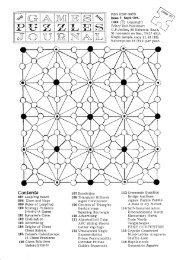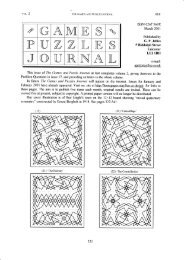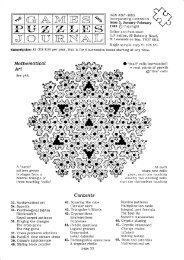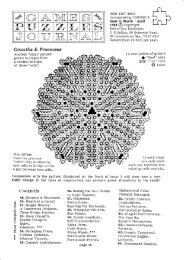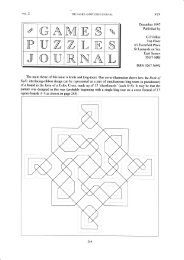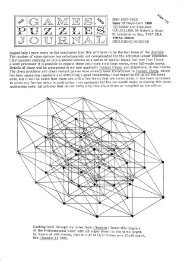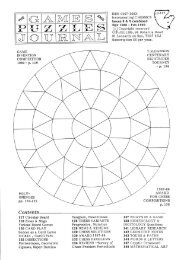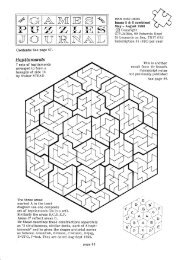Chessics, #28 - Mayhematics
Chessics, #28 - Mayhematics
Chessics, #28 - Mayhematics
Create successful ePaper yourself
Turn your PDF publications into a flip-book with our unique Google optimized e-Paper software.
CHESSICS 28<br />
Pentominoes<br />
The best-known puzzle with the 12 differently shaped 5-square pieces is to<br />
cover a chessboard with them, leaving the four uncovered squares in various, prespecified<br />
positions. Some examples follow. The first three, by T.R.Dawson (FCR<br />
April 1937) show that the four squares can be left in 2x2 formation anywher6lthe<br />
board (10 geometrically distinct positions). The L-shaped piece bordering two<br />
sides of the 2x2 ean be rotated within the 3xB area it occupies to provide other<br />
positions for the 2x2. Computer analysis by D.S.Scott in 1958 (reported in Golombrs<br />
book) counted 65 geometrically different solutions with the 2x2 space in the centre.<br />
The other diagram shows a 2x2 space with all the 5-square pieces abutting edges of<br />
the board. This is also by Dawson (IgE June/August 1938). Similar proofs were<br />
given by Dawson for the T-shaped tetromino (20 positions, FCR Feb/April 1943)<br />
and the L-shaped tetromino (41 positions, FCR April/June 1943).<br />
T.R.D.<br />
T.R.D.<br />
T.R.D.<br />
The next 16 diagrams show other ways in which the four uncovered squares<br />
rnay form a square. The first 9 show all the centro-symmetric cases. The first is<br />
by W.E.Lester (FCR Aug/Oct 1935) the next two by P.B.van Dalfsen (IqR June/<br />
Oct 1953) and ttre Tourth by W.Stead (f'Cn Dec 1954). The others are IioE Pentominoes<br />
(1981) by S.Farhi. There then-Tdliow 6 eases illustrating all the poffil6<br />
positions of the cross-shaped piece within a 3x3 space. The first of these is due<br />
W.E.L. P.B.vD. P.B.vD.<br />
page 140




